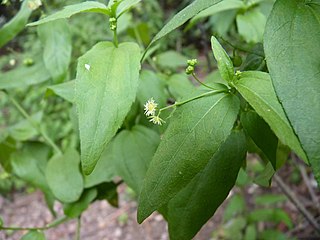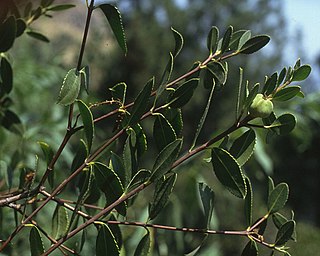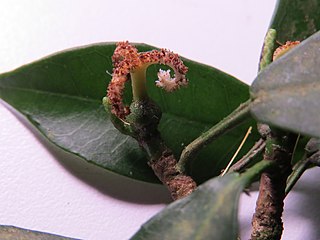Bernardia is a plant genus of the family Euphorbiaceae first described for modern science as a genus in 1754. It is native to North and South America, as well as the West Indies.
Caryodendron is a plant genus of the family Euphorbiaceae first described as a genus in 1860. The genus includes C. orinocense, known as the Inchi tree or Tacay nut. It is native to Central America and South America. They are dioecious trees.
- Caryodendron amazonicumDucke - Amazonas in Brazil
- Caryodendron angustifoliumStandl. - Costa Rica, Panama, Colombia
- Caryodendron janeirenseMüll.Arg. - Rio de Janeiro
- Caryodendron orinocenseH.Karst - Colombia, Venezuela, Ecuador

Caperonia is a genus of plants of the family Euphorbiaceae first described as a genus in 1825. The genus is native to tropical and subtropical America and Africa.

Chiropetalum is a plant genus of the family Euphorbiaceae first described as a genus in 1832. It is widespread across relatively dry regions of North and South America from Texas to Uruguay.

Ditaxis is a plant genus of the family Euphorbiaceae first described as a genus in 1824. Its name comes from Greek dis ("two") and taxis ("rank"), referring to the stamens which are in two whorls. The genus is widespread across much of the Western Hemisphere from the southern United States to Uruguay.
Philyra is a plant genus of the family Euphorbiaceae first described as a genus in 1841. It contains only one known species, Philyra brasiliensis, native to Brazil, Paraguay, and northeastern Argentina.
Angostylis is a genus of flowering plants in the family Euphorbiaceae, first described in 1854. The genus is native to northern South America.

Plukenetia is a genus of plant of the family Euphorbiaceae. It is widespread in tropical regions of Africa, the Indian Subcontinent, Southeast Asia, and the Americas.
Acidoton is a genus of plant of the family Euphorbiaceae first described as a genus in 1788. It is native to the Greater Antilles, Central America, and tropical South America.
Micrandropsis is a plant genus of the family Euphorbiaceae first described as a genus in 1973. It contains only one known species, Micrandropsis scleroxylon, endemic to the State of Amazonas in northwestern Brazil.
Actinostemon is a plant genus of the family Euphorbiaceae first described as a genus in 1841. It is native to South America, Central America, and the West Indies.

Colliguaja is a plant genus of the family Euphorbiaceae first described as a genus in 1782. It is native to South America.
- Colliguaja brasillensisKlotzsch ex Baill. - Paraguay, S Brazil, Uruguay
- Colliguaja dombeyanaA.Juss. - S Chile
- Colliguaja integerrimaGillies & Hook. - S Chile, W Argentina
- Colliguaja odoriferaMolina - N & C Chile
- Colliguaja salicifoliaGillies & Hook. - C Chile
Dendrothrix is a plant genus of the family Euphorbiaceae first described as a genus in 1996. It is native to southern Venezuela and northwestern Brazil.
- Dendrothrix multiglandulosaEsser - Amazonas State in Venezuela
- Dendrothrix wurdackiiEsser - Amazonas State in Brazil
- Dendrothrix yutajensis(Jabl.) Esser - Amazonas State in Brazil; Amazonas & Bolívar States in Venezuela

Gymnanthes is a genus of flowering plants in the spurge family, Euphorbiaceae, first described as a genus in 1788. It is found primarily in the warmer parts of the Western Hemisphere, but with some species in central Africa and southwestern Southeast Asia.

Mabea is a plant genus of the family Euphorbiaceae first described in 1775. It is native to Central and South America as well as Mexico and Trinidad.

Maprounea is a plant genus of the family Euphorbiaceae first named as a genus in 1775. It is native to tropical Africa, Trinidad, and tropical Central and South America.
- Maprounea africana - W + C + S Africa, from Benin to Zimbabwe
- Maprounea amazonica - Colombia, Venezuela, N Brazil
- Maprounea brasiliensis - Brazil, Paraguay, Bolivia
- Maprounea guianensis - Trinidad, Panama, Colombia, Venezuela, French Guiana, Suriname, Guyana, Brazil, Peru, Ecuador, Bolivia, Paraguay
- Maprounea membranacea - Nigeria, Cameroon, Gabon, Equatorial Guinea, Cabinda, Central African Republic, Congo, Zaire
Pseudosenefeldera is a plant genus of the family Euphorbiaceae first described as a genus in 2001. It contains only one known species, Pseudosenefeldera inclinata, native to Panama and to northern and west-central South America.
Rhodothyrsus is a plant genus of the family Euphorbiaceae, first described as a genus in 1999. It is native to South America.
- Rhodothyrsus hirsutusEsser - Colombia, NW Venezuela
- Rhodothyrsus macrophyllus(Ducke) Esser - Guyana, Suriname, Colombia, Peru, N Brazil

Algernonia is a plant genus of the family Euphorbiaceae first described as a genus in 1858. It is native to Peru and Brazil.
Savia is a genus of the family Phyllanthaceae first described as a genus in 1806. It is native to the West Indies, the Florida Keys, Mexico, Venezuela, Brazil, and Paraguay.
- Savia dictyocarpaMüll.Arg. - Paraguay, S Brazil
- Savia sessiliflora(Sw.) Willd. - Mexico, West Indies, Venezuela








